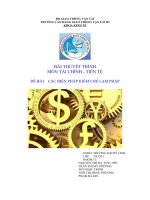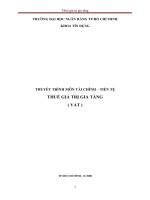Thuyết trình môn tài chính quốc tế giá cả trong nền kinh tế mở ngang giá sức mua prices in the open economy purchasing power parity
Bạn đang xem bản rút gọn của tài liệu. Xem và tải ngay bản đầy đủ của tài liệu tại đây (1.7 MB, 75 trang )
LOGO
Chapter 2
PRICES IN THE OPEN ECONOMY:
PURCHASING POWER PARITY
GVHD: PGS.TS Nguyễn Khắc Quốc Bảo
Nhóm HVTH:
•
•
Tô Thị Phương Thảo
Nguyễn Hoàng Minh Huy
Gustav Cassel
www.themegallery.com
The law of one price in the open economy
•
A digression on price indices
•
Purchasing power parity
•
Purchasing power parity – the facts at a glance
•
Purchasing power parity extensions
•
Empirical research
•
Conclusions
•
8
7
6
5
4
3
2
1
Contents
The law of one price in the domestic economy
In the context of the domestic economy, the law of one price states simply that:
If two goods are identical, they must sell for the same price.
The law of one price in the domestic economy
Example 1
•
Imagine that Michael Jackson is giving a concert at Wembley Stadium in London, a fortnight from now.
•
All the tickets have been sold at face value through the usual distribution channels across the UK
•
but excess demand has created a black market
The law of one price in the domestic economy
Example 1
BIRMINGHAM
£50
?
The law of one price in the domestic economy
Example 1
£50
£ 45
•
there are people who make a living out of exploiting just such situations
•
buy up as many tickets as they could in the cheap location (Manchester) and sell them immediately in the dear location
(Birmingham)
•
making a tidy profit for themselves, driving up the price of tickets in Manchester from £45 and driving down the price in Birmingham
from £50.
£ 47
The law of one price in the domestic economy
Example 1
•
People who make a living by trading rock concert (or football match) tickets on the black market are usually called ‘touts’
or ‘scalpers’.
Arbitrage is the process of buying or selling something in order to exploit a price differential so as to make a riskless
profit.
The law of one price in the domestic economy
Example 1
•
Given the existence of arbitrageurs, are there any factors that could prevent the law of one price prevailing?
Lack of information x
The actual cost of trading: a few trips between the two cities, the price of a small advertisement, some longdistance phone calls, some postage, a few drinks to close valuable deals and oil the wheels, … x
Transaction costs are all the costs associated with a transaction, over and above the cost of the item that actually changes hands.
The law of one price in the domestic economy
Example 1
•
As a specialist trader in large blocks, the scalper’s transaction costs are minimal.
The law of one price in the domestic economy
Example 1
•
Arbitrage will cease to be profitable when the price differential is no greater than the transaction cost per item.
PB is the price of a ticket in Birmingham
PM is the price in Manchester
C is the transaction cost
The law of one price in the domestic economy
Example 1
Are there any other factors we have neglected that may prevent even our modified law of one price from asserting itself?
•
•
ticket touting, whatever its economic benefits, is more or less illegal
transaction cost, C, will be substantially affected by the fact that the business deals involved may amount to a crime
Risk of arrest is the only risk involved. In a pure arbitrage transaction, there are no trading risks in the normal sense.
Arbitrageurs can be regarded as selling their tickets in Birmingham almost at the same time that they buy in Manchester, so
that their actual trading risk is zero. The absence of risk is a distinguishing feature of arbitrage.
The law of one price in the domestic economy
Example 1
The interaction of normal traders – fans wanting to attend the concert and the organizers supplying the seats – these are
the ultimate determinants of the equilibrium, ‘central’ price.
The equilibrium price may also be affected in the short run by the activity of a different species of ticket scalper – one who
holds on to tickets in expectation of higher prices later.
Speculation is the activity of holding a good or security in the hope of profiting from a future rise in its price.
The speculator–tout buys tickets and holds on to them so as to sell them when the time is right – typically, outside the
stadium immediately before the concert starts.
The law of one price in the domestic economy
Example 1
In any market, we may potentially have three different kinds of agent at work:
•
traders (the fans, whose tastes condition their demand, and the organizers, whose costs determine the
supply)
•
•
arbitrageurs (touts who exploit local price variations)
speculators (scalpers who hold on to tickets in the hope of making a ‘killing’)
The law of one price in the domestic economy
Example 2
Could the price in Manchester ever deviate from the price in London?
The transaction cost, C, may be quite substantial in this case, simply because potatoes are costly to move from one end of a country to
the other.
As long as retailers are competitive, they are likely to keep price deviations within the margins set by the costs of transporting potatoes
(wholesalers or
retailers will themselves act as arbitrageurs)
The law of one price in the domestic economy
Example 3
Take a typical manufactured good, for example, a folding umbrella made in China.
Can we be sure that its price will be uniform across the UK?
the law of one price only relates to identical goods
Don’t prices vary even for genuinely identical goods – same model, same
producer, same label?
Yes. The reason lies in large part in the fact that a shopper buys not only the umbrella but also the services of the retailer who sells
it. If the shop itself supplies a retailing service that is above average in prestige, in convenience, in friendliness or helpfulness or
length of opening hours, it will be able to sell its service at an above average price, which will take the form of a premium on some or
all of its wares.
The law of one price in the domestic economy
Example 4
Compare the price of houses in the north (Manchester) and the south (Lon
•
Even if we are careful enough to choose a given type of house for
comparison
(say, semi-detached, three bedrooms, garage and so on), we cannot
avoid the
problem that a house in Manchester is simply not the same asset as a
house in
London.
•
Houses cannot be moved from one end of the country to the other. The transaction cost is not simply high, it is infinite –
at least in the short run.
The law of one price in the domestic economy
Example 5
Can the price of a haircut in London deviate from that in Manchester?
Nothing in economics relies on a distinction between the market for goods and the market for services.
Even if demand is similar, the cost of the main hairdressing inputs (wages, rent and so on) is greater in London, so the supply
curve is further to the left.
The law of one price in the domestic economy
Example 5
Non-traded goods (or non-tradeables) are items (usually services) for which interregional price differentials cannot be eliminated by
arbitrage.
We can say the transaction cost in the case of a haircut is near infinite – not in absolute terms, as was the case with houses, but because,
relative to the cost of the commodity itself, the transaction cost per unit amounts to several hundred or thousand per cent (that is, the cost of
travelling between Manchester and London, relative to the price of the haircut itself).
The law of one price in the open economy
Example 1
An enterprising New York travel agent is selling tickets for the concert – mainly to attract customers for his cut-price trips
to London. If you make him an offer, however, he will sell the concert tickets separately.
The law of one price in the open economy
Example 1
‘compound purchase’: first, buy the dollars, then use the dollars to buy the tickets. In the closed economy context, we
exchange domestic money directly for goods.
When buying from another country, we first have to exchange domestic money for foreign money, then exchange the
foreign currency for the foreign goods.
The law of one price in the open economy
Example 1
The exchange rate is the price of a unit of foreign currency, measured
in units of domestic currency.
$1.25 = £1
$1 = £0.80
Whenever you undertake a compound purchase, buying an item for cash, then using that item to buy a second, the overall price you will
have paid will be the
product of the two prices.
Sterling price of a dollar × dollar price of a ticket = sterling price of a ticket
S: exchange rate
P
NY
: the price in dollars advertised in New York,
SP
NY
: the overall price to a Londoner
L
NY
P = SP
+C
The law of one price in the open economy
Example 1
If there are a significant number of tickets in the hands of New Yorkers, then the London speculator runs an extra risk, over and
above the one borne by the speculator in a closed economy context.
Not only must he gamble on the underlying demand for tickets, but he must also take a chance on the exchange rate.
The law of one price in the open economy
Example 2 & 3
A tariff is a tax levied on goods crossing an international border.
where it is levied at a flat rate per unit, it can be regarded simply as inflating the value of our transaction portmanteau term, C.
More frequently, it consists of a more or less ad valorem tax
In the case of agricultural products, there may be other barriers to international trade. Some countries impose quotas that are
more or less rigid limits on the quantity of a good that may be imported or, occasionally, exported.
The law of one price in the open economy
Example 4 & 5
In the case of so-called non-tradeables, the man-made barriers to trade such as tariffs, quotas, red tape and so on are often
fewer than for
tradeables.
A haircut in New York may turn out to be nearly as close to the price in London as it is to the price in Los Angeles.









